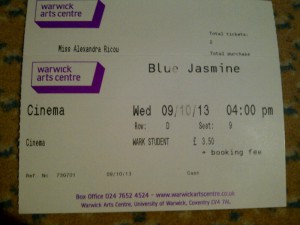Over the past few weeks, I have been overwhelmed by artistic talent and inspiration, all taking place in one brilliantly diverse building; the Warwick Arts Centre. In being a student at the University of Warwick, I have the privilege of sharing my university’s campus space with one of the UK’s largest arts centres; indeed, the Warwick Arts Centre is, in my opinion, the hub of the university. And since having started studying at Warwick a year ago, I have been wowed, entertained and exhilarated by numerous films, plays and performances taking place within the Arts Centre’s walls.
I kicked off this year with a viewing of Woody Allen’s new film, Blue Jasmine, and what a great way to start the year! Though I am not really a big Woody Allen fan, having never particularly been astounded by what films of his I have seen (which I have to admit, are proportionally few), I was nonetheless blown away by Blue Jasmine. It has to be said that the film owes much to the plot structure and characters of Tennessee Williams’ iconic play, A Streetcar Named Desire, but Allen’s construction of dialogue, and the performances by the actors sets this film apart from Allen’s recent cinematic repertoire. Indeed, what particularly stood out for me in this film was the outstanding performance given by Cate Blanchett. I am already a big fan of Blanchett’s work, considering her to be one of the most talented actresses currently working in the film industry, and this film once again proves her talent and skill. She morphs on the screen as the eponymous Jasmine from an insufferable socialite snob, to an unhinged neurotic, to a self-destructive fabricator seemingly without effort. She is, as the Watershed dubbed her, a chameleon, forcing you to empathize and feel Jasmine’s pain however much you deplore her and her actions as she painfully reveals herself and her story through Allen’s carefully crafted narrative. Already a heroine of mine, watching Blanchett reminded me once more of my love of acting, and the power it has as an art form. It is a terrifying creative medium, often requiring its artists to strip themselves of their inhibitions and bare themselves to their audience, emotionally exposed and vulnerable. However, given acting’s power to move and inspire audiences, such dangers are worth the risk. Thus, Blue Jasmine has informed my arts practise by highlighting the power of acting for the screen, as well as the power of well-crafted screenplay with emotionally visceral and well crafted dialogue. This is, of course, useful knowledge in light of my primary and secondary art forms, acting and film-making, as part of Unit 1 Part A of the Gold Arts Award. Blue Jasmine has shown me how film can pick up an actor’s subtle, visual transformation of a character’s emotional journey within a film’s narrative, while a well written screenplay can allow for an emotionally impacting narrative via the medium of film.
The most moving and affecting live creative piece I have seen at the Arts Centre thus far, is Landscape II. Written by performer, writer and sound designer Melanie Wilson, with film and projection by Will Duke, and produced by Fuel, Landscape II cannot be defined by the simplistic term of a play, but more aptly as a performance. I watched the piece in the capacity of a Student Arts Representative reviewer for the Arts Centre, having been a part of the piece’s online marketing campaign for the Arts Centre, which particularly targeted student audiences. It was interesting watching the performance specifically from a critic’s perspective, and I enjoyed writing the review as part of the production’s promotional campaign. Certainly, I was deeply moved by this piece, loving the use of multi-media strands, such as projected film, spoken narrative and sound-scapes to create a narrative that was truly emotive and captivating. Landscape II informed my arts practice by opening my mind to the possibilities of unconventional story-telling that can walk the line between pretension and failure, and succeed as a beautiful, thought-provoking piece of art. As someone interested in writing and film making, this piece really struck a nerve with me, and proved to me that there are forms of expression yet unseen or unaddressed in the creative forum of the theatre. Indeed, I would love to now experiment further with the narrative style of my writing, and push the boundaries of student performance before I graduate from Warwick by exploring how a narrative for performance can be conveyed to an audience through a combined art forms such as sound and film, as well as live performance.
